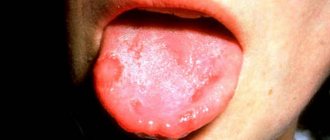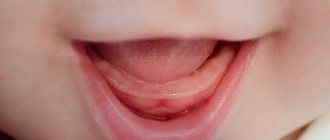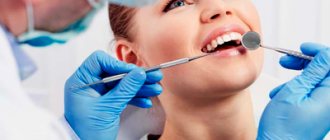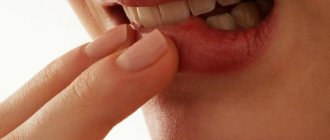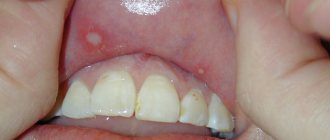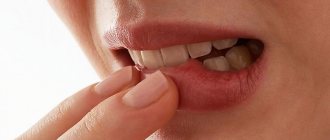Last update: 03/03/2021
Dry lips in a child can turn from a small nuisance into a big problem if care is not taken in time. But it is very easy to ignore this problem - young children may remain silent and not complain, fearing the terrible treatment with pills and injections.
In fact, there are a dozen causes of dry skin. The most common ones seem very simple, but still constantly provoke peeling and cracking of the lips.
How to deal with dry lips in a child?
To care for a child’s lips, only special cosmetics based on natural ingredients, without chemical dyes and fragrances, are suitable. In winter, before going outside, be sure to treat your baby’s lips with a rich hygienic lipstick, which will nourish and protect from the cold, while also lasting long enough.
An alternative to lipstick can be regular baby cream. If you are very dry, you can apply it in a thick layer at night. You can also lubricate your lips with olive or sea buckthorn oil - it leaves a nourishing and protective film on the lips, even if you lick it off.
Balm "La Cree" combines the best of active natural ingredients that soften and heal the skin. This hypoallergenic product can be used for very young children. Active ingredients include: shea butter, almond and castor oils, avocado extract, beeswax, vitamins A and E. This set provides comprehensive care at any time of the year.
Journal "Child's Health" 6(9) 2007
Cheilitis (lip disease) is an inflammation of the red border, skin and mucous membrane of the lips. The clinical features of cheilitis are determined by the morphological and functional maturity of the integumentary tissues of the lips. It is customary to distinguish between independent and symptomatic cheilitis.
Independent cheilitis includes: traumatic, exfoliative, contact allergic, meteorological, glandular, microbial cheilitis. Depending on the nature of the course, acute and chronic diseases of the lips are distinguished.
Traumatic cheilitis develops as a result of damage to the lips (mechanical, chemical, thermal) and subsequent infection. The mucous membrane of the lip is clearly hyperemic, swollen, and tense. There is pain and limited mobility. Sometimes cheilitis is observed in children as a complication of mycotic, herpetic lesions. Treatment consists of prescribing antibacterial therapy: gentamicin, synthomycin, irrigation with inhalipt, as well as other antiseptic and anti-inflammatory drugs.
Exfoliative cheilitis is manifested by peeling of the red border of the lips (usually the lower) and has a chronic course. According to ICD-10, K 13.0 is classified as diseases of the lips, including exfoliative cheilitis. An important role in the occurrence of this type of cheilitis is played by incomplete, incorrect closure of the lips, hypovitaminosis of ascorbic or nicotinic acids, B vitamins, dysfunction of the central nervous system, and the thyroid gland. Exfoliative cheilitis has dry and exudative forms. In the dry form, gray or grayish-brown scales appear on the red border. The scales fall off easily, the adjacent mucous membranes are not damaged. Children complain of dry lips and the appearance of scales. The exudative form is manifested by the appearance of grayish-yellow or yellowish-brown crusts on the red border, sometimes large in size and hanging from the lip when rejected. After removing the crusts, a bright red, smooth surface is visible, there are no erosions. Patients are concerned about a burning sensation, soreness, tension in the lips, and their swelling.
Treatment consists of maintaining nasal breathing and restoring full, correct closure of the lips. Local applications of natural oils and vitamin-containing substances are prescribed: carotoline, rosehip oil, retinol, carophylene ointment. Creams are widely used: “Calendula”, “Spermaceti”. The presence of an exudative form determines the prescription of boric or boron-vaseline ointment.
Contact allergic cheilitis is more common in children over 7 years of age and is a reflection of a delayed-type allergic reaction. The reason for it is the contact of the mucous membrane of the lips with various chemicals (the habit of holding various objects in the mouth, sometimes a reaction to certain elixirs, toothpaste). Clinically, erythema forms on the mucous membrane and peeling begins.
In some cases, against the background of inflammation, small blisters appear, after opening which become weeping. Children complain of itching, dryness, burning in the lips. Treatment consists of immediately stopping contact with the allergen and prescribing antihistamines. Anti-inflammatory therapy is carried out locally - 1% solution of mephenamine, 1% solution of salicylic acid, treatment of lips with anesthetic with glycerin. If treatment is ineffective, use hormonal ointments for a short course of up to 4-6 days.
Meteorological cheilitis occurs when exposed to cold, wind, solar radiation, and high humidity. Hyperemia and infiltration of the lips appear, their surface is dry and may be covered with crusts. Children complain of a burning sensation and a feeling of tightening of the lips. Treatment involves eliminating the factors that caused cheilitis and prescribing photoprotective fatty creams and ointments. In severe cases, hormonal ointments are used for a short time.
Glandular cheilitis is an inflammation of the minor salivary glands of the lips (chronic). According to ICD-10, K 13.0 is classified as diseases of the lips, including glandular cheilitis. The presence of a congenital anomaly of the salivary glands, lip biting, chronic injuries, a psychogenic factor, and genetic predisposition are important. Teenagers get sick more often. They are concerned about dryness, soreness, peeling of the lips, cracks, erosion, maceration. The excretory ducts of the minor salivary glands are dilated, the mucous membrane of the lips is bright red. The chronic course of the disease causes an increase in lip volume. When pressing on the lips, a secretion is released from the glands in the form of transparent or cloudy drops.
Treatment consists of prescribing antibiotic ointments, hormonal drugs, and electrocoagulation of the salivary glands. According to indications, antibiotics are used either intramuscularly or intramuscularly, sulfonamides, and general ultraviolet radiation.
Microbial cheilitis is most often caused by streptococcal infection or Candida fungi. The disease is more common in young children with reduced immunological reactivity. Children complain of swelling of the lips, peeling, pain, and cracks. There are chronic streptococcal and mycotic cheilitis. In weakened children, streptococcal impetigo is sometimes diagnosed. A phlyctena (a type of abscess) with serous-purulent, then purulent contents is formed. After a few days, crusts form at the site of the conflicts, and when removed, erosion occurs. This disease is contagious. If a repeated staphylococcal infection occurs, vulgar impetigo develops, manifested by severe itching. The results of bacteriological examination determine the treatment tactics. General hygienic approaches are combined with oral sanitation and antibiotic therapy. The most commonly used are gentamicin ointment and cream, syntamicin liniment, furacilin, rivanol ointments and ointments containing zinc oxide. For pyoderma and purulent processes on the lips, a 2% aqueous and alcoholic solution of brilliant green is used.
Symptomatic cheilitis includes atopic, eczematous, macrocheilitis, and hypovitaminosis.
Atopic cheilitis is characterized by a chronic course and manifests itself as atopic dermatosis or diffuse neurodermatitis. A significant role in the occurrence of the disease belongs to the factors that cause atopic allergies (exo- and endoallergens). Diseases of the digestive system and nutritional disorders are of particular importance. An exacerbation of the disease is usually observed in the cold season.
Erythema with a clearly defined border and swelling appear on the red border of the lips and adjacent areas. The child is bothered by itching, and later crusts appear. After relief of acute inflammation, lichenification of the lips is observed, the red border is infiltrated, and swelling of the lips is noted. Small radial grooves on the red border and slight peeling are detected. Lichenification of the lips is a characteristic manifestation of atopic cheilitis and is manifested by thickening of the skin, intensification of its pattern and impaired pigmentation.
Treatment consists of prescribing antihistamines and vitamins. Sometimes histaglobulin is used, and in severe cases, corticosteroids are used. In parallel, antibacterial, anti-inflammatory drugs, and ointments with corticosteroids are used locally. For lichenification and infiltration, ointments with naphthalan and sulfur are used. Of particular importance is a properly selected diet, excluding spicy foods and limiting carbohydrates.
Eczematous cheilitis is one of the manifestations of a serious disease - eczema. A significant role is played by food, microbial, chemical, and drug allergens. In the acute form of the disease, hyperemia, swelling of the lips, merging blisters, maceration, and crusts are observed. In a chronic course, the red border is compacted due to infiltration; in some areas there are nodes, blisters, and crusts. Sometimes painful cracks and bloody crusts form. Treatment also includes antihistamines, vitamins, an elimination diet, and carbohydrate restriction. In severe cases, hormonal drugs are prescribed.
Steroid-based ointments are used locally: oxycort, lorindene, triamcinolone, dexamethasone. As improvement progresses, sulfur-tar ointment, boron-tar ointment, and 10–20% naphthalan ointment are prescribed. At night, it is recommended to lubricate your lips with ointments containing calendula, carotoline, and solcoseryl. Lubricating lips with natural fats has proven successful.
Macrocheilitis (Melkerson-Rosenthal syndrome) has a chronic relapsing course and occurs as a result of exposure to infectious and allergic factors. A decisive role is played by disruption of microcirculation of blood and lymph in the tissues of the lips. The disease begins with swelling of the lips, cracks and scales appear. The skin in the area of edema is pale, sometimes cyanotic. The thickening of the lips is uneven; when pressing with fingers, a depression is not formed. This pathology is characterized by three symptoms: macrocheilitis, folded tongue and facial paralysis, usually unilateral.
Treatment consists of prescribing prednisolone, antibiotics, and hyposensitizing drugs. Ointments with heparin and dimexide, electrophoresis with heparin, lidase, mud and paraffin treatment are used locally.
The correct closure of the lips and breathing are constantly monitored. A mandatory component of treatment is myotherapy and lip massage. The duration of the course of treatment is usually 1–1.5 months, repeated courses after 2–3 months.
Hypovitaminous cheilitis manifests itself as chronic cracked lips. A special role belongs to group B hypovitaminosis and retinol. According to ICD-10, there are E 51 - thiamine deficiency and E 53 - deficiency of other B vitamins. Failure to maintain lip and oral hygiene, bad habits of biting or licking lips contribute to the appearance of cracks. Most often, one linear, painful crack of varying depth appears. It is localized, as a rule, in the center of the lower lip (sometimes to the side of the center). In treatment, reparants of the epithelium of the mucous membrane are used - rosehip oil, carotolin, retinol, ointments of plant origin, natural oils and fats.
Experts' opinion
According to the results of clinical studies, which involved 50 children aged 0 to 5 years, the products were proven to be highly effective, safe and tolerable for daily skin care of children with mild to moderate forms of atopic dermatitis and during remission, accompanied by a decrease in the quality of life of patients . As a result of therapy, including the use of lip balm, a decrease in the activity of the inflammatory process, a decrease in dryness, itching and flaking was noted.
La Cree Lip Balm has been confirmed to:
- relieves discomfort and dry skin
- restores dry and chapped lips
- moisturizes and protects the delicate skin of the lips from cold and wind
The lack of vitamins can be replenished with the help of children's multivitamin complexes (they differ from adults in composition and dosage), lubricate the lips with vitamins from capsules and, of course, eat more foods rich in vitamins.
To humidify indoor air, you can use special humidifiers or simply place containers of water next to the radiators.
Symptoms
The main signs of the disease are:
- swelling, cracks;
- races forming in the corners of the mouth;
- peeling and dryness, a burning sensation;
- yellow or gray crusts;
- soreness, development of blisters from which pus can be released.
Diagnosis and treatment
The disease has a code of 10–K13.0, which determines the probable causes and symptoms. When the first signs appear, you should contact your dentist and pediatrician, which will help to identify problems in a timely manner, conduct a diagnosis and begin treatment. Early treatment allows therapy to be effective and to avoid worsening.
Treatment of angular cheilitis in children requires complex measures. Depending on the severity of the condition, antibacterial ointments or gels, immunostimulating agents, and multivitamin complexes are prescribed. The diet is adjusted to include more dairy products, fruits and vegetables. If persistent wound formation is observed, antibiotics are required. If there is no improvement, an additional appointment with specialized specialists, for example, a gastroenterologist, dermatologist and others, is recommended. For candidiasis, antifungal drugs are prescribed.
The treatment regimen usually includes:
- topical agents, gels or oil compresses on the affected area;
- anti-inflammatory drugs;
- ointments based on hormonal agents;
- sanitation of the child’s oral cavity;
- antibiotics;
- vitamin complexes;
- eliminating the causes of the disease;
- exclusion of factors that have a negative effect on tissue.
Prevention
The process of inflammation can be prevented by removing or minimizing negative external factors. It is necessary to teach the child to stop licking the corners of the mouth and lips, and to use hygienic lipsticks or gels when dry. For dry skin, it is permissible to use creams intended for children and adolescents.
As a preventive measure, you need to adjust your diet. It is recommended to exclude from the diet sour and spicy foods, too salty dishes that irritate the mucous membrane. It is necessary to increase the amount of non-acidic fruits and vegetables, foods with a high content of riboflavin and iron.
About Us
My Ort Dental Clinic offers services for the treatment of diseases in children. We provide the following benefits:
- offices equipped with modern technical equipment;
- comfortable conditions for Patients of any age;
- qualified children's specialists;
- comprehensive services, including diagnosis, treatment and monitoring of achieved results;
- favorable price.
You can visit us at the address: St. Petersburg, st. Yesenina, 1, building 1. We work seven days a week, you can make an appointment using a convenient form on the website or by phone.
Constantly dry lips in a child may be a symptom of a disease
If your baby’s lips are constantly dry: in any weather, under any diet, cosmetics do not help them, perhaps this is how the body indicates the presence of a more serious disease.
- Problems with the thyroid gland.
- Diabetes mellitus is also accompanied by increased thirst.
- With dryness, cracking and the appearance of various crusts - fungus, psoriasis.
- Autoimmune diseases are a complex of diseases usually associated with damage to the skin and bone tissue. They are based on the body's immune reaction against itself.
In these cases, it is necessary to consult a doctor for a serious diagnosis.
Sources:
- I.I. Ryumina, V.V. Zubkov, Newborn skin care, Healthy Child magazine, 2017
- V.V. Chebotarev, N.V. Chebotareva, M.S. Askhakov, E.V. Bronnikova, Sensitive skin: causes, methods of therapy, journal Medical Bulletin of the North Caucasus, 2015
- Drobinskaya, A. O. Fundamentals of pediatrics and hygiene of children of early and preschool age / A. O. Drobinskaya. - Moscow: Higher School, 2016. - 400 p.
Photos of diathesis
Photo album on the disease
One of the methods of treating diathesis is local therapy.
The complex treatment of diathesis includes local therapy in the form of ointments and gels. They should only be prescribed by a specialist, and he takes this issue very seriously, since the main role in the appearance of signs of diathesis is given to allergens that affect the child’s skin.
What drugs are often included in the list prescribed by a doctor:
- To soften and quickly heal the skin: Bepanten, zinc ointment, Desitin (zinc-based ointment).
- For disinfection, softening and prevention of the formation of new crusts: Diaderm, Glutamol.
- To suppress an allergic reaction: Fenistil, Vibrocil, Cetrin.
It is worth considering that ointments are not the main way to treat diathesis, since they do not affect the cause in any way. Local therapy is used as an auxiliary method. The basis of treatment should be diet, proper care, and avoidance of contact with allergens.
What to do if a child has diathesis
Local therapy using ointments is one of the components of complex treatment. But both hormonal and non-hormonal drugs should be prescribed by a doctor individually for each baby, taking into account the characteristics of the diathesis.
Self-medication in such a situation is not only ineffective, but also dangerous for the child’s health. Therefore, it is better to contact competent specialists. PsorMak employs doctors with extensive experience in treating diathesis.
We take a comprehensive approach to diagnosis and treatment, and for local therapy we use ointment made according to our own recipe without the addition of hormones.
She has been helping our patients at our clinic for more than 25 years, so we guarantee a complete cure without side effects. Contact us for a consultation so we can begin solving your problem. April 5, 2020
Author of the article: dermatologist Mak Vladimir Fedorovich
What are the types of cheilitis in childhood?
Traumatic cheilitis - most often occurs as a result of thermal, mechanical or chemical damage to the lips with subsequent infection. Pain occurs, the mucous membrane of the lips tenses and swells, movements are limited. In children, cheilitis can be a complication of herpetic lesions. For this type of disease, treatment consists of taking anti-inflammatory, antiseptic agents and antibiotics.
Exfoliative cheilitis is accompanied by peeling of the lips. It can occur due to a deficiency in the body of B vitamins, nicotinic or ascorbic acid, improper lip closure, and disturbances in the functioning of the nervous and endocrine systems. Treatment depends on the cause. In this case, it is necessary to restore proper lip closure, observe nasal breathing, and use various creams and vitamins.
Contact allergic cheilitis can occur more often at school age. Its cause is contact of the mucous membrane with chemicals. The disease is accompanied by peeling, small bubbles may form, and children also complain of burning, itching and dryness. Treatment consists of eliminating the allergen and taking antihistamines.
Meteorological cheilitis in childhood can occur as a result of exposure to solar radiation, low temperatures or high humidity. With this form of cheilitis, dry mucous membranes and skin, crust formation, infiltration, and hyperemia can be observed. Patients complain of a feeling of tightness and burning. Treatment: it is necessary to eliminate the causes that caused cheilitis, as well as use various creams and ointments (if necessary, hormonal).
Grandular cheilitis is manifested by inflammation of the minor salivary glands of the lips. Most often it occurs with congenital anomalies of the salivary glands, hereditary predisposition, or trauma. It is manifested by such symptoms as pain, peeling, dryness, redness of the mucous membranes of the lips, cracks, erosions, and the appearance of cloudy discharge when pressed. Treatment of this form is carried out using antibacterial ointments and hormonal agents.
Microbial cheilitis in children most often occurs as a result of exposure to fungi of the genus Candida and streptococci. Young children who have reduced immunity are most often affected by the disease.
Symptomatic cheilitis in children
Hypovitaminous cheilitis is manifested by cracks on the lips. The disease develops due to a deficiency of retinol and B vitamins. Cracks can occur as a result of non-compliance with general hygiene rules, the habit of licking or biting lips. Treatment: use of mucosal epithelium reparants - carotolin, rosehip oil, retinol.
Eczematous cheilitis is a symptom of a general eczematous process in which the surface layers of the skin become inflamed. Its treatment involves the use of steroid ointments. As soon as the condition improves, the doctor may recommend ointments such as naphthalan, sulfur-tar or boron-tar.
Macrocheilitis is manifested by cracks, pallor, swelling of the lips, and the appearance of scales. Treatment is carried out using hyposensitizing drugs, hormones, antibiotics, ointments with heparin and dimexide.
Atopic cheilitis is accompanied by swelling, itching, peeling, swelling, and erythema. After some time, crusts form. Treatment - antibacterial and antihistamines, anti-inflammatory drugs, ointments with corticosteroids, vitamins. It is necessary to limit carbohydrates and avoid spicy foods.
